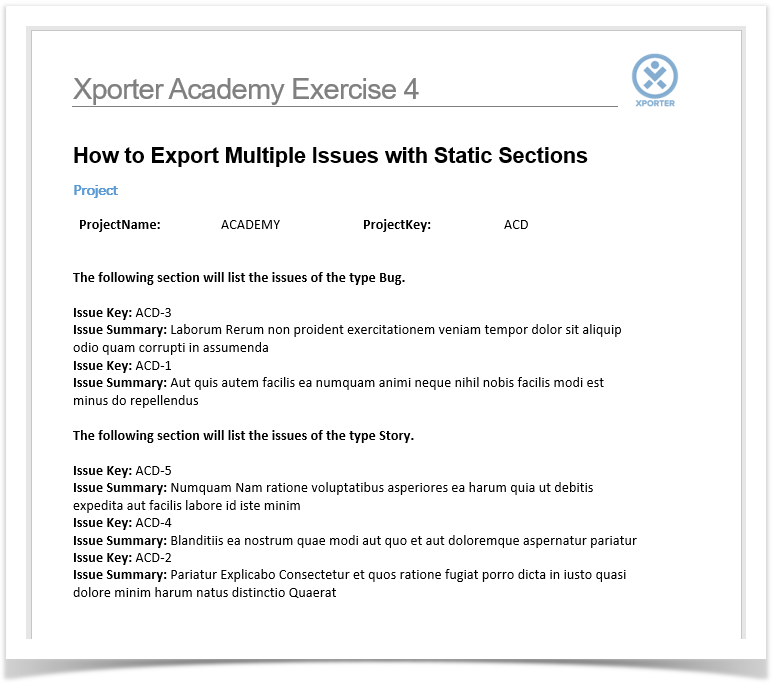Sometimes, you may want to export the contents of multiple issues without repeating some certain sections of the template. For instance, you may want to display some information only at the end/beginning of the document.
On This is the fourth exercise , youin the Basic level. You'll learn how to export information from multiple issues on a Section of a single template.
| Info |
|---|
In order to To provide this functionality, Xporter for Jira plugin supports a special notation. This notation allows defining You can define which sections of the template will be populated for each issue, and which sections will be static. For further more information, please check refer to our documentation here. |
The notation we'll use is demonstrated below:
This is the header of the Bulk Export, ; this section will be rendered a single time. &{for issues} This is the footer of the Bulk Export, ; this section will be rendered a single time. |
...
You can even push this functionality to another level by applying filters to the iteration. This can be useful if you want to place the issues of a specific type (ex: e.g., Bug) in a section of the template and the issues of another type (ex: e.g., Story) in another section.
The This notation we'll use is demonstrated below:
The following section will list the issues of the type Bug. &{for issues|filter=%{'${IssueTypeName}'.equals('Bug')}} Issue Key: ${Key} Issue Summary: ${Summary} &{end} The following section will list the issues of the type Story. &{for issues|filter=%{'${IssueTypeName}'.equals('Story')}} Issue Key: ${Key} Issue Summary: ${Summary} &{end} This is the footer of the Bulk Export, ; this section will be rendered a single time. |
| Info |
|---|
When using XLSX templates please take , note that to define an iteration for multiple columns, you need to merge a row of columns and define the &{for issues...} inside that merged cells. The same thing should be made to define the &{end} of the same iteration. All content between the &{for issues...} definition and the &{end} won't will not be duplicated for each iteration. For further more information, please check refer to our documentation here. |
Below there is a sample of how the mappings will be displayed in a Word template:
...
- A static section iteration
- Headings
- Text styling
Below there Below is a sample of how the generated file will be populated:
Below there is a sample of how the mappings will be displayed in an Excel template:
...
- A static section iteration
- Headings
- Text styling
Below there Below is a sample of how the generated file will be populated:
...
| Info |
|---|
If you like this exercise, please share your opinion on the page by just leaving leave a comment or a Thank you in advance. Enjoy our product. |
| Expand | ||||||||||||
|---|---|---|---|---|---|---|---|---|---|---|---|---|
| ||||||||||||
Here 's the Exercise 4 related Docx filesare the files related to this Exercise:
Here's the Exercise 4 related Xlsx files:
|
